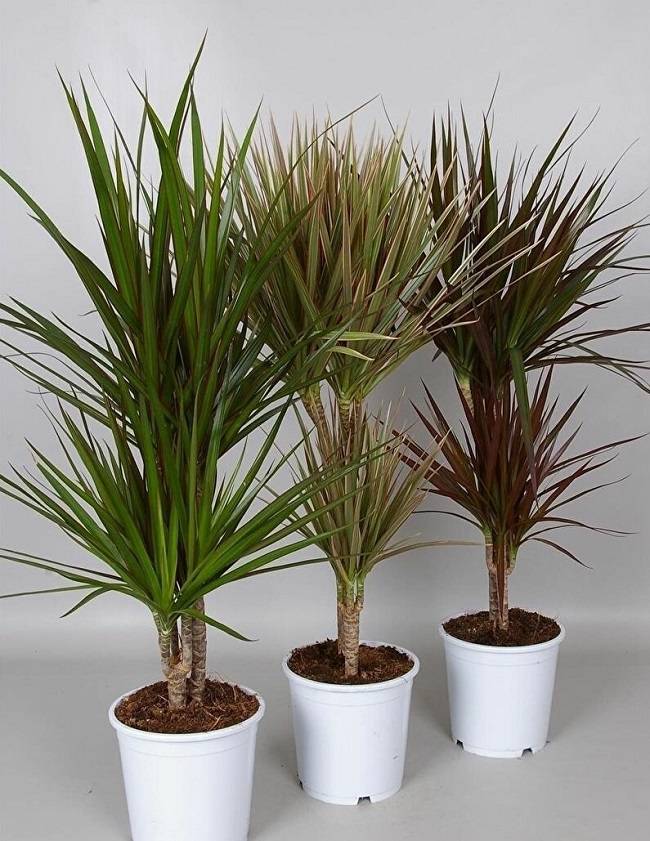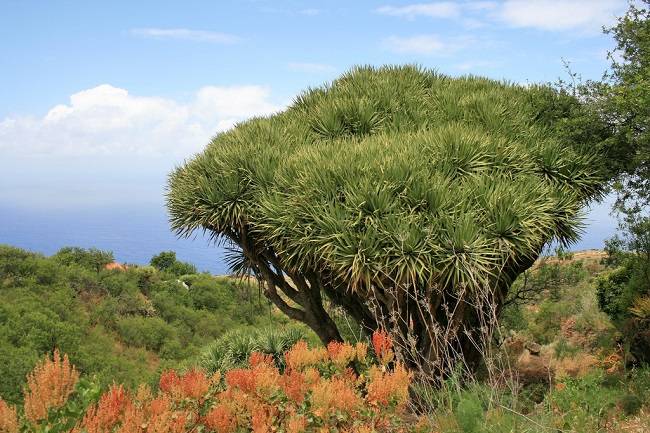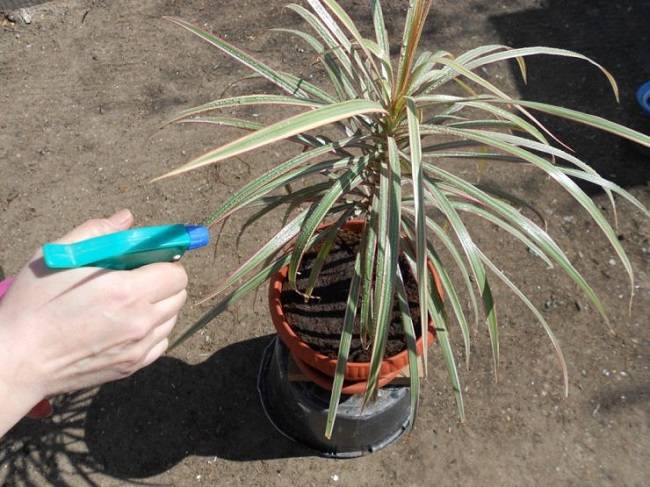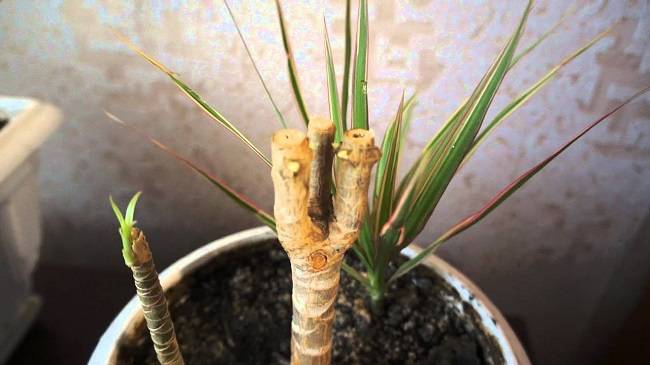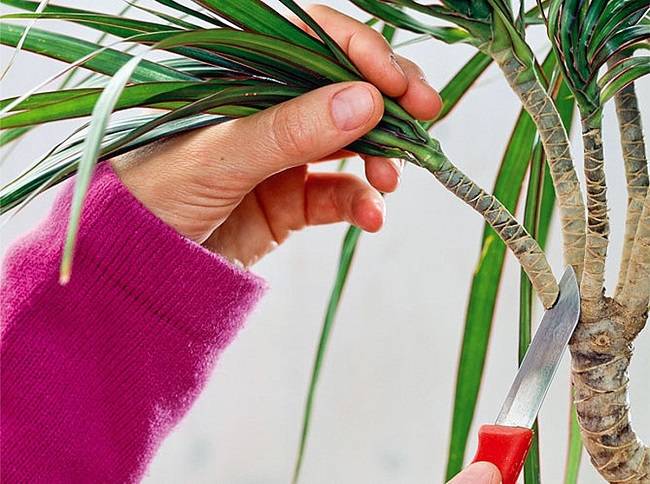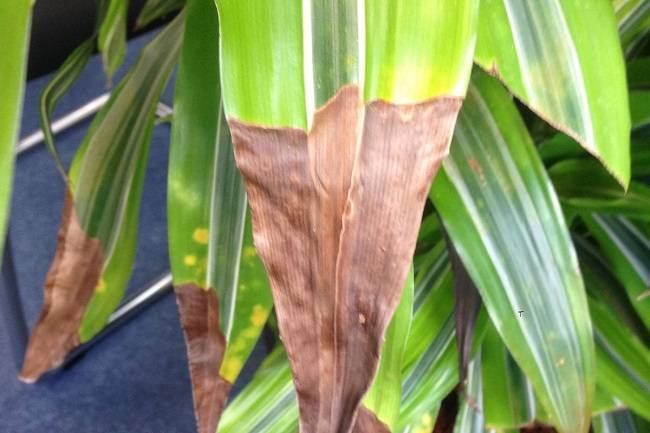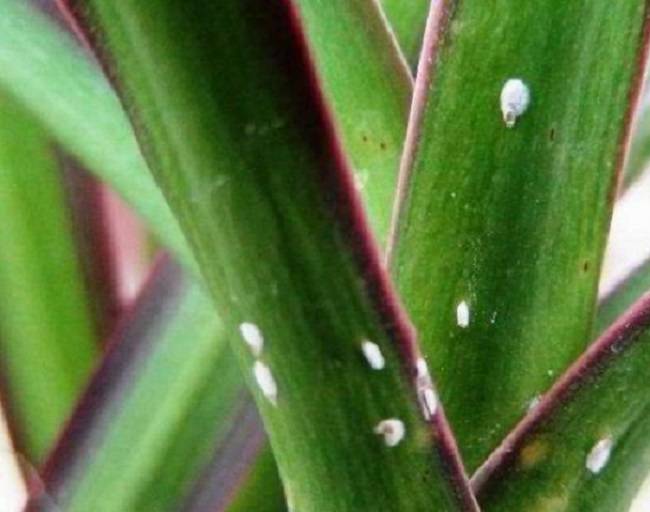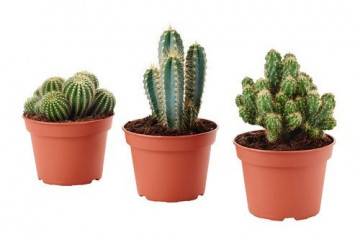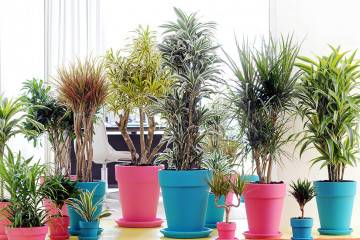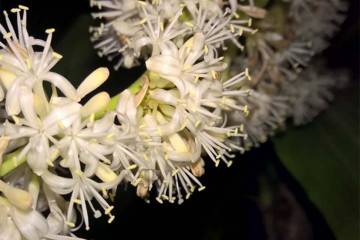Dracaena Marginata - how to plant and care
Content:
Dracaena is a plant that grows in the wild. In the conditions of houses and apartments, only some varieties are able to grow. One of the brightest and most attractive representatives is Dracaena Marginata.
What does Dracaena Marginata look like, which family does it belong to?
Dracaena marginata is an evergreen perennial plant that belongs to the Asparagus family. It is a tree with a smooth trunk and long narrow leaves at the top, the height of which reaches from 1.5 to 3 meters at home. In nature, it can grow up to 5 meters.
Leaves up to 70 cm long have red stripes bordering the edges. For this plant it received another name - bordered dracaena.
Common types
The division into species is based on the stripes on the leaves and their color. The following are the most famous types of dracaena Marginata:
- dracaena magenta (magenta). Easy-care plant with dark green leaves bordered with a raspberry strip;
- dracaena margarita. Compact tree with rich green foliage;
- dracaena colorama. The stripes on the leaves are red and wide. They take up most of them, so a clear green color can only be seen on the back;
- dracaena tricolor. The leaves of the species contain not only red and green colors, but also yellow. This variety creates a delicate shade.
- lracena bicolor. The leaves of this plant are bordered by a narrow red stripe.
Healing properties
The plant itself is not a drug. However, it has useful properties. Growing in homes and apartments, it purifies the air and kills harmful bacteria. Special preparations based on dracaena help to cope and prevent diseases associated with the cardiovascular system, nervous disorders. The plant helps to strengthen teeth, bones and muscular system. It absorbs harmful electromagnetic radiation from household appliances and computers.
Dracaena is often used in alternative medicine and cosmetology. Creams and face masks are made from it, which improve skin color and smooth wrinkles.
History of appearance
The decorative tree comes from the island of Madagascar. It is also called the Madagascar Dragon Tree. Scientists have not yet determined when and how dracaena appeared. There are several legends about this.
The word "dragon" in the title is not accidental. According to one of the legends, a long time ago, dragons fought with elephants. But one day, a dying elephant fell on a wounded dragon. Their blood mixed and sprayed onto a nearby tree. This explains the red sap and the same coloring of some species.
Features of flower care
Dracaena Marginata is a tree that is unpretentious to care at home. You just need to be careful and follow the basic requirements.
Temperature
The homeland of the plant is sunny Madagascar.Because of this, it is very heat demanding. The optimum temperature for Dracaena Marginata is 20-25 ° C. At a temperature of + 16 ° C, growth may stop. If the thermometer drops below + 12 ° C, the plant will die.
In the house, the plant should be kept away from heat sources, drafts and proximity to air conditioners and fans should be avoided. In summer, it is allowed to move it outside in a shaded place, without drafts.
Lighting
Dracena likes well-lit places, but it must be protected from excessive influence of direct sunlight. Variegated varieties should be grown away from windows using artificial lighting. Varieties with green leaves do not need such conditions.
Watering
The plant does not tolerate excess moisture. Only the topmost layer of the soil should be moistened. Watering is carried out in moderation - 1-2 times a week. With this mode, the ground at the roots will always be slightly damp.
Spraying
For better growth and cleaning from dust, you can spray the dracaena with warm water or use a warm shower once a week. It is better to use fine atomizers. This procedure can be used if there is not enough moisture and the tips of the leaves dry out.
Humidity
The optimum humidity for dracaena is 40%. At a lower level, the leaves will begin to dry. To increase moisture, you can spray the leaves and air around the plant. It would be wise to wipe the leaves with a damp cloth 2 times a week. You can put a container of water next to the plant.
Priming
A slightly acidic soil is suitable for a tree to grow comfortably. You can purchase a ready-made substrate for palms and succulents. If there is a desire, then it is possible to make it with your own hands. It is necessary to mix garden soil, sand and humus in equal proportions.
Top dressing
The root system of the dracaena grows rapidly, and the nutritional value of the soil decreases. To avoid this, you need to feed the plant with liquid fertilizers 1-2 times a month. Supplements are suitable for palms and dracaena or deciduous trees.
Before fertilizing, the plant needs to be watered more than usual. And then apply fertilizer diluted in water.
Features of care in winter, during the rest period
There are no special changes in the care of the bordered dracaena during the cold season. Watering is reduced to once a week. Also, the plant must be sprayed regularly. Do not keep it near radiators.
Bloom
In indoor conditions, dracaena practically does not bloom. In nature, its flowering is inconspicuous and faded. Small white flowers form on the plant. Flowers are collected in inflorescences - panicles. They have a pleasant delicate aroma.
Pruning
In order for the dracaena to retain its presentable decorative appearance, it needs to be rejuvenated by pruning. The cut trunk and crown can not be thrown away, but used for reproduction.
Step-by-step instructions for pruning:
- cut off the stem with a sharp clean tool, leaving a small stump;
- sprinkle the cut with crushed coal to prevent infection and disease. Can be filled with paraffin;
- put a plastic bag on the stump and secure it tightly;
- after about 20 days, buds will appear and new shoots will develop;
- after the appearance of the first shoots, keep the greenhouse for another 1-2 months;
- then the bag is removed and the plant continues to grow.
How Dracaena Marginata reproduces
Dracaena reproduces in several ways.
Germinating seeds
Seed propagation is very rare. Seeds quickly lose their germination and become unusable. If, nevertheless, the seeds of a blooming dracaena are caught, then the formation of buds will begin only in the 10th year of life, subject to all conditions.
Seeds can be sown at the end of winter directly into the ground or first germinated on a napkin.In the first option, the seeds are soaked in a solution of a growth stimulant and sown into the soil with a distance of 5 cm. After the sprouts have reached a height of 5 cm, they are sown separately.
In the second option, the seeds are laid out on a moistened napkin, which is then wrapped. The wrapped napkin is placed in a container with a small amount of water. After germination, the seeds are planted in separate pots.
Rooting cuttings
The procedure for propagation by cuttings is as follows:
- the top is cut off along with the stem (10-15 cm);
- the remainder of the stem is cut into cuttings;
- the places of the upper sections are treated with paraffin;
- dry for about an hour.
Then you can start rooting. There are two ways: in water and in soil.
In water:
- the cuttings are dipped into a container of water;
- before that, an activated carbon tablet is added there. The water should be at room temperature;
- roots will begin to form in a couple of weeks. After letting them grow another 4 centimeters, the cuttings can be planted in the soil.
In the ground:
- cuttings are treated with a dry root stimulant;
- are planted in the ground;
- from above they are covered with a film, creating an impromptu greenhouse;
- every day the film must be lifted by airing the cuttings for 15-20 minutes;
- they should be lightly sprayed, mixing fertilizers into the water for root feeding;
- the rooted stalk will grow in shoots.
Air layering
A neat cut must be made on the trunk. To prevent the bark from growing together, a plastic strip is inserted into the incision. Then the place of the incision is wrapped in a little damp sphagnum moss, and tied with a film on top.
After a while, roots will begin to form on the stem. When they are already old enough, the stem is cut off below the film. Further, part of the stem with roots is planted in a separate pot. The stump remaining on the adult plant will also give new shoots over time.
Other options
There is also a method - also, with the help of cuttings. Cut cuttings are not planted, but placed horizontally in a container with a substrate. Then they are slightly pressed into the ground, while not filling up their ends. Rooting should be expected in 1.5 months, and after 2 - sprouts will already appear. The plant has practically formed, it remains to take proper care of it.
Transfer
Before starting the transplant, the new pot should be washed with a saturated solution of potassium permanganate. The container itself should be 2 cm larger in diameter and a couple of centimeters higher than the old one. Too large a pot is not needed, moisture can stagnate in it, which will lead to direct rotting of the plant.
It is better to replant using the transshipment method. If rotting of the root system is observed, then the damaged part of the roots is cut off, and the places of the cuts are sprinkled with crushed coal. The transplant is carried out as follows:
- for a start, 4 cm of the drainage layer is poured into the pot (expanded clay or fine gravel);
- then the plant is neatly placed;
- sprinkled on top with a layer of earth. It should rise no more than 3 cm above the upper roots.
After successfully carrying out this operation, the dracaena should be watered a little (100 ml of water is enough). The earth should be moistened no deeper than the upper roots. Further, watering should be carried out once a week.
Possible growing problems and diseases
Dracaena is an indoor plant, therefore it is not susceptible to many diseases. However, if not properly cared for, it can become the target of insects or get sick.
Leaves fall
Falling leaves is a natural process. But if they fall massively, this is an alarming sign. There are several reasons for this problem: violation of the root system, lack of water, its excess, lack of fertilizers. In any case, the plant lacks nutrition, and therefore it seeks to get rid of the excess, that is, the leaves.
Pale spots appear
Such a nuisance is a symptom of a sunburn. The plant should be removed to a darker place.
Leaves turn yellow and dry
If this happens, then an urgent need to revise the irrigation schedule. Dracaena does not have enough water, so the leaves (in more severe cases and the stem) dry and turn yellow. Increase the amount of water for irrigation.
The stem becomes soft, midges and an unpleasant odor appear
Such symptoms are a sign of waterlogging and root decay. To prevent further death of the plant, it is necessary to dig it up and cut off the damaged parts of the root. If there is too much damage, it is better to cut the cuttings from the healthy part of the stem and get a new copy.
Pests
The main pests:
- aphid. Insects actively eat young leaves and the top. Warm soapy water will help, followed by a shower. Such actions must be repeated for several days until the insects are completely gone;
- scabbards. Affected leaves are covered with dark plaques. In especially severe cases, they turn red and yellow, and the soil turns black. Machine oil, undiluted vinegar, or rubbing alcohol are helpful against insects. By wiping them with these substances, the pests will weaken in a couple of hours and they can be washed off with a warm shower. After that, the soil should be replaced;
- mealybug. The attack of these insects is manifested by gray flakes on the foliage. To begin with, they are treated with soapy water and washed off with a warm shower. During the next 10-12 days, the plant should be treated with drugs like "Calypso";
- thrips. At the first damage, silvery spots are formed, then they turn black and increase. The funds "Spintor", "Actellik" will help;
- spider mite. Small harmful insects that twine around the plant with threads, similar to cobwebs, can do a lot of harm. First, dracaena needs to be treated with any alcohol mixture, and after 20-25 minutes, rinse with a warm shower. The funds "Apollo", "Neoron", "Sunmight" will also help. For prevention, you can illuminate the leaves from all sides with a quartz lamp.
Other problems
Sometimes dracaena can become ill with bacterial or viral diseases. Symptoms are as follows - wet spots on the leaves, yellow longitudinal stripes, stunted growth. Such diseases are incurable, the best option would be to destroy the plant, and disinfect the tools and the pot.
Signs and superstitions
One very interesting omen is associated with dracaena. If you plant such a plant at home, then it will certainly bring happiness and prosperity. The roots of this sign grow from an ancient Aztec legend.
Once a simple warrior fell in love with the daughter of the high priest. He will allow the guy to marry his daughter if he can get the stick to dissolve the leaves. The young man watered a stick every day, and once leaves appeared on it. It is believed that a piece of bark cut off at the full moon of this tree will bring happiness.
Dracaena Marginata is a special plant. Behind the nondescript appearance, reminiscent of a palm tree, there is a unique tree that can make the owner happy, and not only because of the legend.
